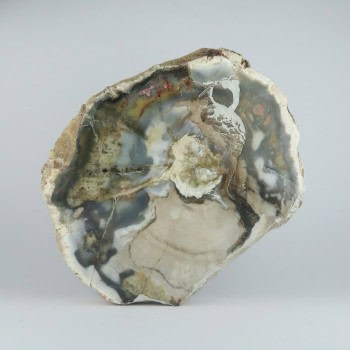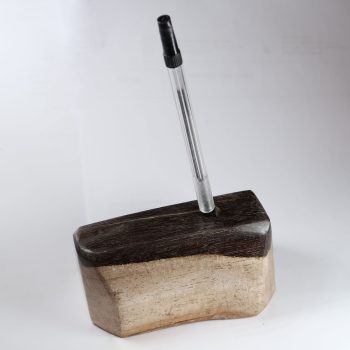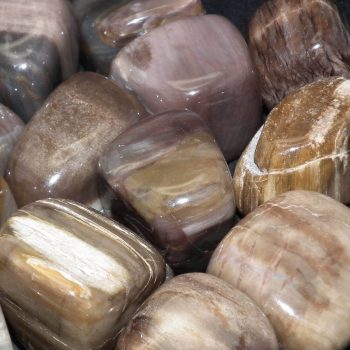Petrified Wood
The fossilised result of ancient plants, trees, and organic materials that have turned to stone over millions of years.
It is often sold rough, as it is found – or sometimes polished, which does show off the wood grain really nicely.
Showing all 3 results
-

Petrified Wood – polished slices
Price range: £1.50 through £10.00 -

Petrified Wood pen holder
£10.00 -

Petrified Wood Tumblestones
Price range: £2.00 through £3.50
Appearance, Uses and History
Petrified Wood is a fossilised form of wood in which the original organic material has been replaced by minerals – including chalcedony, agate, opal, coal, pyrite… the list is quite extensive. The majority of the fossilised wood on the market will be Silica based, though.
The process begins when a piece of wood or woody material is rapidly buried by mud or another wet sediment – this could be silt, volcanic ash, etc. The lack of oxygen slows the rotting of the wood, which allows various minerals to replace the wood over time. Volcanic ash is particularly known for producing petrified wood due to the large amounts of silica released.
Locales
Petrified Wood is found in a huge amount of locations worldwide; it occurs from the Devonian, when ‘woody’ plants first evolved, to almost the present day. I have found pieces of petrified wood in streams all over the country; it is often found in the form of Stigmaria, coal, or Jet, too.
Particularly large deposits of fossilised wood are found in numerous places – most sold online comes from Africa and Australia. Excellent quality specimens of Opalised wood can be found from Australia and Indonesia.
I would say it is fair to assume that some petrified or fossilised wood can be found in almost every country on Earth. A rarer phenomenon is a petrified forest – an area with a large amount of more complete wood in one area; sometimes this can be in the form of largely complete trees or standing logs.
There are numerous petrified forests in the USA, including the Petrified Forest National Park, the Ginkgo Petrified Forest State Park, the Gilboa Fossil Forest, the Mississippi Petrified Forest, the Yellowstone Petrified Forest, the Escalante Petrified Forest State Park, and the California Petrified Forest. However, there are fossilised forests in other countries too – Argentina, Australia, Brazil, Ecuador, Egypt, Germany, Georgia, Greece, India, Indonesia, Italy, Japan, Libya, Namibia, New Zealand, Thailand, Turkey, and the United Kingdom.
If you’re interested in visiting a local one and you’re a UK reader (most of you are!) – unfortunately, we don’t have anything quite as visually impressive as the American national parks. However, smaller areas can be visited around the UK at certain times. Some are on beaches and only visible with favourable conditions when a storm rips parts of the beach away, some are on private land.
- Glasgow, Scotland
- Lulworth, Dorset
- Whitby, Yorkshire (deposits of ‘Whitby Jet’ rather than a distinct forest)
- Wrexham, Wales
The UK also has numerous ‘submerged forests’; forests that have been buried under peat, sediment and water and well preserved for thousands of years. They are typically only visible from time to time when storms clear sand and peat from the beaches. These are often considered to be ‘sub-fossils’, partially fossilised specimens which either have not fully completed the fossilisation process or were buried in sub-optimal conditions.
- Bigbury Bay, Devon
- Borth, Ceredigion, Mid Wales
- Cleveleys, Lancashire
- Cley, Norfolk
- Daymer Bay, Cornwall
- Low Hauxley, Northumberland
- Penzance, Cornwall
- Portreath, Cornwall
- Redcar, Yorkshire
- Tywyn, Wales
- Ynyslas, Ceredigion, Mid Wales
Mineralogy
Hazards and Warnings
Almost all rocks, minerals (and, frankly, almost all other substances on earth) can produce toxic dust when cutting, which can cause serious respiratory conditions including silicosis.
When cutting or polishing rocks, minerals, shells, etc, all work should be done wet to minimise the dust, and a suitable respirator or extraction system should be used.
Translations
‘Petrified Wood’ is likely a term aimed directly at the English speaking market, so this section includes translations for ‘petrified wood’ and ‘fossilised wood’, and occasionally terms like ‘silicified wood’ or ‘silica replaced wood’.
Arabic:
- الخشب المتحجر
- خشب متحجر
Hindi:
- सख्त लकड़ी
- जीवाश्म लकड़ी
- लकड़ी का जीवाश्म
- ओपल की लकड़ी
Portuguese:
- Madeira petrificada
- madeira fossilizada
- madera fosilizada
- fóssil de madeira
- madeira silicificada
- madeira agatizada
Bengali:
- পেট্রাইফড কাঠ
- জীবাশ্ম কাঠ
Indonesian:
- kayu membatu
- fosil kayu
- silika menggantikan kayu
- kayu silisifikasi
- kayu opal
Punjabi:
English:
- petrified wood
- fossilised wood
- silica replaced wood
- silicified wood
- opalised wood
- agatised wood
Italian:
- legno pietrificato
- legno fossilizzato
- fossile di legno
- la silice ha sostituito il legno
- legno silicizzato
- legno opalizzato
- legno agatizzato
Russian:
- окаменелое дерево
- окаменелая древесина
- ископаемое дерево
- опаловое дерево
French:
- bois pétrifié
- bois fossilisé
- bois fossile
- la silice a remplacé le bois
- bois silicifié
- bois opalisé
- bois agatisé
Japanese:
- 珪化木
- 化石化した木材
- 木の化石
- オパールの木
- アガタイズドウッド
Spanish:
- madera petrificada
- madera fosilizada
- fósil de madera
- madera reemplazada por sílice
- madera silicificada
- madera opalizada
- madera agatizada
German:
-
versteinertes Holz
- Holzfossil
- Kieselsäure ersetzte Holz
- verkieseltes Holz
- opalisiertes Holz
- agatisiertes Holz
Korean:
- 화석화 나무
- 나무 화석
- 오팔 나무
Thai:
- ไม้กลายเป็นหิน
- ไม้ฟอสซิล
- ฟอสซิลไม้
Gujurati:
Mandarin and Traditional Chinese:
- 矽化木
- 二氧化矽替代木材
- 硅化木
- 二氧化硅替代木材
Urdu:
- جیواشم لکڑی
